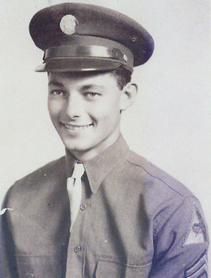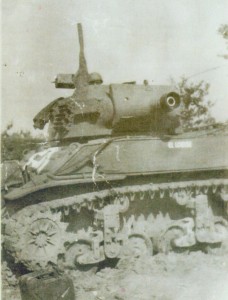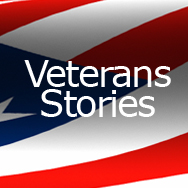Cross The Rhine With Dry Feet – Courtesy Of The 9th Armored Division

December, 1941, shortly after December 7th, Pearl Harbor Day, Bobby enlisted as a volunteer for which his mother had to signed for to enlist. Was sent to Camp Beaugard, Louisiana just south of New Orleans. The first week of January, 1942, was sent to Ft. Riley, Kansas and arrived on a cold winter snow day with 2-4 inches on the ground to CRTC (Cavalry Replacement Training Center) the old horse Cavalry. After several months of training, was sent to one of three main camps of Ft. Riley – – Camp Funston. We had been in training for the 2nd Cavalry Division, which was to be sent to the Philippine Islands to reinforce the 1st Cavalry Division. The Philippines fell to Japan – – this changed things.
2nd Cavalry Division started the movement to armor. We were organized as the 92′”‘ Cavalry Reconnaissance Squadron with horses, jeeps, and 6-wheeled half tracks. Later, we became the 89th Cavalry Reconnaissance Squadron Mechanized, part of the 2nd Cavalry Division, assigned to the 9th Armored Division and began to train in all seriousness.
We ended up in full desert training from there the 9th Armored Division was sent to the swamps of Louisiana for training in 1944 – – towards New York for shipment overseas. On the trip to New York area, “E” Troop, the assault gun (75M) howitzer, light tank, designed for speed-close infantry support and street fighting) was notified that we were now on DS – – meaning Detached Service to the 99th Infantry Division which was in England for the invasion of Europe.
From New York, we (“E” Troop 89th Cavalry) boarded the Queen Mary for overseas duty and landed in Glasgow, Scotland – – (2&1/2 days) – – boarded the famous “Flying Scott” train which could really fly non-stop South Hampton, England, a seaport in southern England and 18 miles across the English channel to France. On arrival, “E” Troop by platoons were placed in tents with 12 cots for beds with a large coal-fired stove for heat. From here “E” Troop went north in England to a very large open field which us assault gun tankers were told to pick out our tank, clean the preservation coating from rust, fuel the tanks, with trailers, for the return trip to the area near South Hampton. That field was loaded, row after row, with our tanks as far as the eye could see.
On arrival, we loaded the tanks and trailers with fuel, ammunition, 75MM, 50 caliber machine- gun ammo and Army “C” rations for a week for a crew of 4, plus water cans. June 6th, 1944, “D” Day, headed for France – third wave. Landed 3 degrees off course – – landed at the point which divided Omaha and Utah beachheads. Headed inland towards St. Lo, France (hedge-groove country) where the battle for St. Lo ended in final victory after four weeks. Stalemate of battle after invasion of France followed – – finally the American Army broke out of stalemate and a running gun battle continued for France wherein over 400,000 German Troops were captured and we, “E” Troop of the 89th Cavalry Reconnaissance Squadron ended our DS (detached service to the 99th Infantry) and rejoined our Squadron and the 9th Armored Division at Metz, France near the border of Germany. Regrouped, took on supplies and toured the French Maginot Fortress facing Germany.
Later, the 9th Armored Division was assigned the area along the border of Luxemburg/Germany, Eternack the Southern end – St. Vith on the northern end, a 60 mile stretch. “E” Troop was stationed at Bovange, Luxemburg. Midnight of December 16,1944, we, the 1st Platoon tanks of”E” Troop DS service assigned to “A” Troop of the 89th Cavalry Reconnaissance Squadron for the duration of the war, were ordered to Etenternach, Luxemburg, the southern end of the “bulge” to help stop the German advance south as the great “battle of the bulge** had begun. Following this stop, my tank and my companion tank commander, Floyd Nichols, were to requested to rejoin our assigned “A” Troop if we could find them as they were scattered from hell to breakfast as were so many other members of the 89th Cavalry & 9th Armored troops. Our two tanks joined others scattered Troopers on a hit and run retreating battle towards Bastone, Belgium where we joined the besieged troops of Bastone. After the seige at Bastone was broken and the beginning of the end of the “Bulge” Battle, fresh troops from the US took up the battle to push the Germans back into Germany, word was spread throughout the battled area that the 9th Armored Division troops were to gather in the area SE of Leige, Belgium, to reorganize, received replacement men, equipment, and supplies. Afterwards, the 9th Armored Division received its orders to go the attack once again. The target industrial city of Colonge, Germany.
The battle for Colonge lasted about 4 days and, at Midnight, my tank and my sister tank commander, Floyd Nichols, led Combat Command “A” of the 9th Armored
Division, on our continued attack south n the West bank of the Rhine river. At Midnight, March 4th, 1945, my tank and sister tank of Floyd Nichols, circled the town of Remagen, Germany, and continued on into the valley to the Rhine river where we found the Lundenburg, passenger/railroad, bridge still in tack across the Rhine River. We notified our platoon leader, S/Sgt Bill Douglas, by radio of our position and that the bridge was intact. We were told to hold our positions until we heard from him. 2&1/2 days later we met the lead elements of the 27th Armored Infantry Division of the 9th Armored Division whose orders were to take the bridge.
After we crossed the Rhine river, my tank and my sister tank of Floyd Nichols, led Combat Command “A” of the 9th Armored Divison south on the East bank of the Rhine river fight gun battles along the way to Koblenz, Germany to help General Patton get across the Rhine river. Afterward, our two tanks led Combat Command “A” towards Limburg, Germany where a good battle ensued. Afterwards we pursued north, fight small battles on the way to the industrial city Leipzig where a great weeks battle followed. We captured 122 German 88 Artillery guns – that is how hard they defended the city. This was the last big battle of the war for us.
We then headed due south to meet the Russians, which we did. Later, continued our march south, our two tanks leading Combat Command “A” towards Czechoslovaks where Combat Command “A” setup headquarters in the resort city of Carlsbad, Czechoslovaks. My tank and sister tank of Floyd Nichols continued on east where we ended up in the capital city of Prague, Czechoslovaks where we received word to “cease fire” the war has ended. The celebration was on.
Later, “E” Troop (my Troop) was assigned to Bayreuth, Germany, due west of Czechoslovaks, the home of the famous German Lica camera factory, which was empty, as our city of occupation. Here, we found 2200 displaced Polish men, women, & children which I later be came in charge of and finally, after several months, I escorted them to Warsaw, Poland.
As the occupation continued and men started to leave and return home as they became eligible, I was promoted to First Sergeant. Later in 1945,1 was directed to Camp Strike near the port of Cherburg, France and was in charge of soldiers scheduled to return home. I later got to schedule my own return to the US and aboard the Cruiser USS Portland. On arrival in New York City, I was put in charge of a Troop train of soldiers with their discharge papers and saw that at designated stops (4) I made certain that each received his discharged papers and left the train. The last stop camp Robinson at Little Rock, Arkansas where I caught another train to Oklahoma City and a cab to home. All this was in December, 1945. January 8, 1946, Louise and I were united in marriage in El Dorado, Arkansas and settled in Oklahoma City.
Enclosed is a copy of some of my achievements in service.
I never lost a tank or crewmember during the war. (the tank had a lot of battle scars)
1941 Entered Military Service at Shreveport, Louisiana Mother Required to sign for my entering the service
Honorable discharged as First Sergeant Dee. 1945
Received the following during four years of service:
3 Bronze Stars for bravery under enemy fire
1 Purple Heart – Germany 88MM shrapnel North of Limburg, Germany
Presidential Unit Citation for The Battle of The Bulge
Awarded Government Citations for Service By: The Country of Luxemburg, The Country of Belgium, The Country of France

PS: In four years of service – – two years of training together my tank crew was
Walter Bagley – – Tank Driver – – Pennsylvania; Odell Meyers – – Gunner – – Iowa;
Joseph Beneke – – Gun loader and manned the 50 caliber machine gun – – New Jersey; And – – Bob Cobb – – Tank Commander
